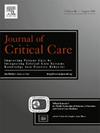Current challenges in understanding, diagnosing and managing sepsis-induced cardiac dysfunction
IF 2.9
3区 医学
Q2 CRITICAL CARE MEDICINE
引用次数: 0
Abstract
Sepsis is a severe, life-threatening condition, which may be responsible for multiple complications, including cardiovascular events. Despite being a common complication, sepsis-induced cardiac dysfunction (SICD) is still not entirely understood. This review underlines the diagnosis challenges, discusses the prognosis and proposes a diagnosis path for patients with suspected SICD. Existing severity scoring systems are not able or designed to predict the risk of cardiac dysfunction in septic patients. Current biomarkers are not sufficient for the diagnosis of SICD, only for the exclusion of acute myocardial infarction. Troponin levels may be negative or slightly elevated in sepsis-induced cardiac dysfunction and natriuretic peptides are significantly more elevated in septic patients who develop cardiac dysfunction. Electrocardiogram changes are not always present. However, ischemic ST-T changes might be observed. Furthermore, sepsis is a risk factor for developing new-onset atrial fibrillation. Repeat echocardiography remains the crucial diagnosis method used to describe this reversible cardiac disorder. Acute cardiac dysfunction in septic patients requires a differential diagnosis between acute coronary syndrome, myocarditis, Takotsubo Syndrome and SICD. A combination of clinical, biochemical or imaging data is not yet validated for diagnosing SICD.
理解、诊断和管理败血症引起的心功能障碍的当前挑战
败血症是一种严重的、危及生命的疾病,可能导致多种并发症,包括心血管事件。尽管败血症引起的心功能障碍(SICD)是一种常见的并发症,但仍未完全了解。本文综述了SICD的诊断挑战,讨论了预后,并提出了疑似SICD患者的诊断途径。现有的严重程度评分系统不能或设计用于预测败血症患者心功能障碍的风险。目前的生物标志物不足以诊断SICD,只能排除急性心肌梗死。在脓毒症引起的心功能障碍中,肌钙蛋白水平可能为阴性或轻微升高,而在脓毒症患者中,利钠肽水平明显升高。心电图改变并不总是存在。然而,可以观察到缺血性ST-T改变。此外,脓毒症是发生新发心房颤动的危险因素。重复超声心动图仍然是用于描述这种可逆性心脏疾病的关键诊断方法。脓毒症患者的急性心功能障碍需要鉴别诊断急性冠脉综合征、心肌炎、Takotsubo综合征和SICD。临床、生化或影像学数据的结合尚未被证实可用于诊断SICD。
本文章由计算机程序翻译,如有差异,请以英文原文为准。
求助全文
约1分钟内获得全文
求助全文
来源期刊

Journal of critical care
医学-危重病医学
CiteScore
8.60
自引率
2.70%
发文量
237
审稿时长
23 days
期刊介绍:
The Journal of Critical Care, the official publication of the World Federation of Societies of Intensive and Critical Care Medicine (WFSICCM), is a leading international, peer-reviewed journal providing original research, review articles, tutorials, and invited articles for physicians and allied health professionals involved in treating the critically ill. The Journal aims to improve patient care by furthering understanding of health systems research and its integration into clinical practice.
The Journal will include articles which discuss:
All aspects of health services research in critical care
System based practice in anesthesiology, perioperative and critical care medicine
The interface between anesthesiology, critical care medicine and pain
Integrating intraoperative management in preparation for postoperative critical care management and recovery
Optimizing patient management, i.e., exploring the interface between evidence-based principles or clinical insight into management and care of complex patients
The team approach in the OR and ICU
System-based research
Medical ethics
Technology in medicine
Seminars discussing current, state of the art, and sometimes controversial topics in anesthesiology, critical care medicine, and professional education
Residency Education.
 求助内容:
求助内容: 应助结果提醒方式:
应助结果提醒方式:


